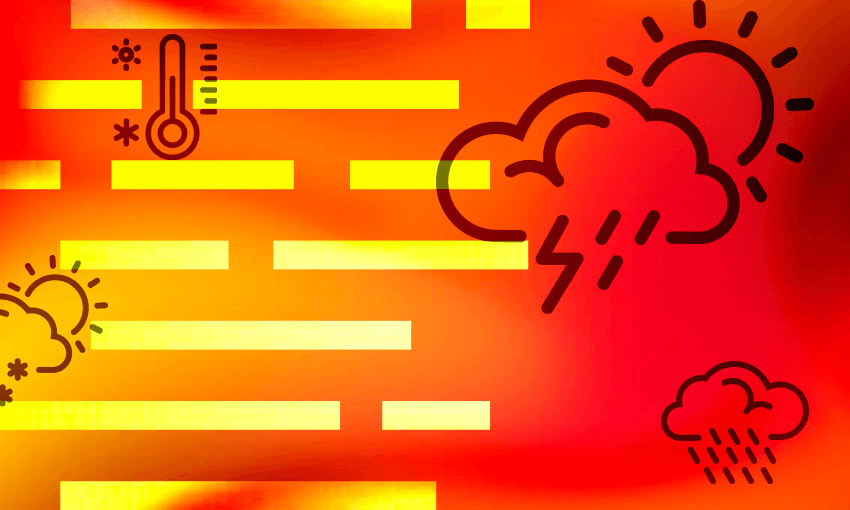Weather experts are telling New Zealanders to batten down the hatches for the months ahead, which they’re predicting will be ‘far from normal’.
From flash flooding in parts of the North Island to hotter-than-normal temperatures in Canterbury and Otago, the coming months are going to be a testing time for New Zealanders, according to AMI’s team of weather experts. “[Weather patterns] strongly suggest summer weather conditions are going to be far from normal,” says Bruce Buckley, AMI’s principal specialist in meteorology. He wants people to be prepared.
The northern parts of the North Island will be at great risk of flash and river flooding throughout summer due to bursts of heavy rainfall, his team predicts. Think of the flooding events in Westport and Auckland. He says to watch out in early 2022, particularly autumn.
The east coast of the South Island will be more prone to heavy rain too, including hail (although that’s only slightly more likely than normal). Buckley’s colleague, Dean MacGregor, AMI’s executive general manager, claims, says people should prepare and “batten down the hatches a bit”. He recommends moving some outdoor items, like chairs or tables, pot plants or toys, inside, and tying down trampolines and swing sets.
It can also help to clear out the gutters to prevent water pooling and trim heavy trees near the home so they don’t become waterlogged and break off into the house.
Indoors, MacGregor recommends moving valuables and appliances up off near the floor where you can. And, naturally, checking the details of your house and contents insurance coverage.
Blame the watery chaos on higher sea surface temperatures swirling around in the Pacific Ocean. Buckley explains they create more “active” weather systems, which feed more moisture into already-existing rain systems to create heavier downpours. A system fed by these tropical systems can dump two to three times more rain than one without, he says.
On the other end of the weather spectrum, east of the Southern Alps has a greater chance of seeing wildfires during their hot summer months, similar to the 2020 fires in Lake Ōhau. Higher temperatures create dry conditions that will forge fuel aka dry grass, leaves and shrubs. Incoming north-easterly winds could help those fires to spread.
MacGregor recommends prepping for potential fires by planting and watering a ring of lawn around the house and clearing leaves and flammables away. Buckley adds that time is of the essence. “It’s too late to start clearing gutters and planting grass once the fire’s moving.”
The AMI team’s predictions are partially based on information from Niwa and Buckley says the two are complementary. “I have a more ‘what these weather systems and these anomalies will do’ approach in terms of their impacts.”
Niwa has just issued its seasonal climate outlook for November through to January and it tells much the same story.
But according to Niwa’s principal scientist for forecasting and media, Chris Brandolino, New Zealanders might see some of those soaring temperatures sooner rather than later.
Temperatures across Aotearoa have already been above average, he says, and the country – most likely somewhere in Hakwe’s Bay, Gisborne, eastern Canterbury or interior Otago – will likely see its first 30-degree day in the first two weeks of November.
“That [temperature peak] will get things under way, then we’re expecting a burgeoning or mushrooming warmth as we work our way through November,” he says.
Brandolino cautions not to take any cooler days as a sign of the months ahead. “Good marriages have bad weeks. Sure, there’ll be some cool days but that won’t define the three-month period,” he says.
As part of its outlook, Niwa has issued a La Niña alert for the summer, the second in as many years. La Niña is characterised by colder-than-average water near the equator but warmer-than-average waters west of the date line.
It’s “the steering wheel of Mother Nature’s car”, as Brandolino puts it. The warm and cool waters create those north-easterly winds and active weather systems and are a key ingredient for tropical cyclones. And yes, there’ll be a slightly higher-than-average number of those too, around three in the islands near New Zealand and one to two extratropical cyclones hitting Aotearoa.
Like Buckley and MacGregor, Brandolino advises to get ready for summer now. Buy a fan to combat hot, humid nights or put a little extra cash aside for air-conditioning bills. People living rurally should check their rainwater tanks, especially farmers relying on water for irrigation and their animals.
Niwa’s three-month forecasts are based on patterns of rainfall, temperatures, winds and so on from the past 20 years. Meteorologists weigh up these different climate conditions and calculate how likely they think it is that the weather this time around will be the same, more or less intense.
Climate change makes extreme weather events more likely to occur, more extreme and longer in duration, says Brandolino. “A warmer Earth means more extreme rainfall events, more intense and longer heat waves, more droughts, et cetera,” he says.
It also means more of what Brandolino calls “binge rainfall”. He likens it to binge watching 10 hours of Netflix in a single day, instead of spreading it out over a full week.

